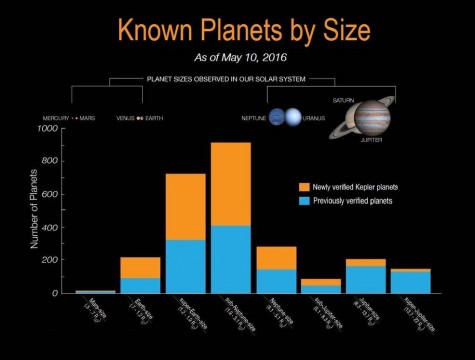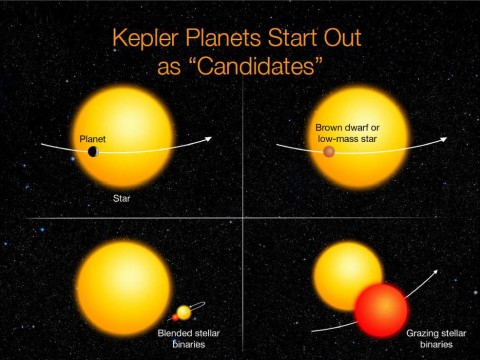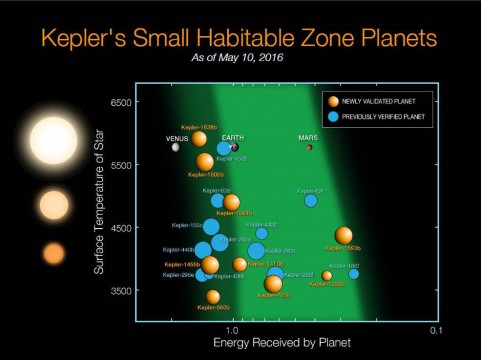Even though Kepler’s primary mission ended three years ago, the data it collected just revealed a mother lode: 1,284 newly confirmed planets.

NASA Ames / W. Stenzel
Over the course of four years, the Kepler spacecraft stared at a tiny patch of sky teeming with stars and tallied up 4,696 exoplanet candidates. But for years now, many have remained just that: candidates. To confirm any one planet requires difficult, time-consuming follow-up observations. And the smaller candidates are out of reach of even the largest ground-based telescopes. After years of follow-up observations, the list of confirmed planets stood at 1,041 — nothing to sneeze at, but nowhere near complete.
Now that list has just doubled in size. With the newest study from the Kepler team, the confirmed planets now number 2,325.
Timothy Morton (Princeton University) and colleagues accomplished that feat by taking a different tack than their predecessors. Acknowledging that follow-up observations wouldn’t be possible for all planet candidates, the team didn’t look for additional evidence supporting a planet’s existence. Instead, they searched for signs that the planet wasn’t there. Then they calculated the chance that what looked like a planet was actually an imposter. Any candidate with less than a 1% chance of being fake is now considered real.
Planet Imposters

NASA Ames / W. Stenzel
When astronomers look for transiting planets, they never actually see the planet itself. Instead they see a dip in the host star’s light as the planet passes in front of it. But other astrophysical sources can mimic that dip. The most common imposter is an edge-on pair of stars whose mutual orbit blinks on and off in the background — an eclipsing binary.
Morton and his team took a two-pronged, fully automated approach to determining whether a signal was an imposter or a real planet. Their code first examined the signal itself — a real planet transit will block the star’s light in a certain way that can sometimes be distinguished from imposters. Then the code factored in how common imposters might be. For example, how common are binary stars, and how many lie in the direction Kepler was looking?
The algorithm studied each planet candidate for several minutes, then spit out a probability that the signal is a fake. And as long as that probability was less than 1%, the candidate moved to the confirmed list.
All in all, 1,935 planets were confirmed in this way, including 651 that had already been confirmed by some other method. And 428 candidates (generally those with large radii, whose signals are more easily faked by other astrophysical sources) were flagged as imposters.
Several thousand candidates remain in limbo, not quite flagrant enough to be flagged as fakes, but not quite convincing enough to be confirmed either. These candidates await improvements to Morton’s algorithm, follow-up observations, or both.
In the Habitable Zone
Of the newly confirmed planets, nine orbit in their star’s habitable zone, the region in which a planet with an Earth-like atmosphere could sustain liquid water on its surface. Add that to the dozen already known, and astronomers have assembled a decent size of potentially habitable planets.

NASA Ames / N. Batalha / W. Stenzel
Moving On
It’s simply amazing that the Kepler team is still returning a bonanza of exoplanet results almost three years after two reaction wheel failures blew the primary mission. But now we’re nearing the end. The mission will close out in a year and a half, says mission scientist Natalie Batalha (NASA Ames), though we can expect one last Kepler catalog sometime next year. The secondary K2 mission is still going strong and will likely end in mid-2018, when the spacecraft runs out of fuel.
“We’re getting ready to pass the baton to future missions,” Batalha adds, namely, the dynamic duo: the Transiting Exoplanet Survey Satellite (TESS) and the James Webb Space Telescope (JWST).
 4
4









Comments
Bob
May 11, 2016 at 1:27 pm
Monica Young...
Thank you for this interesting article about the Kepler recent list of confirmed planets.
The color charts (Known Planets By Size, and Kepler's Small Habitable Zone Planets) are fantastic.
One question (of many that I have):
What is the size (distance from known stars) of the habitable zone?
Thanks again.
...Bob Patrick
You must be logged in to post a comment.
Anthony Barreiro
May 13, 2016 at 3:39 pm
Bob-Patrick -- the size of a star's habitable zone will vary with the size, temperature, and brightness of the star. A bigger, hotter, brighter main-sequence star will have a habitable zones with an inner circumference that is farther out from the star, and an outer circumference that is also father out from the star, when compared to a smaller, cooler, dimmer main-sequence star.
A quick internet search turned up this nifty calculator. You can input different conditions for the star and see how the habitable zone changes.
http://depts.washington.edu/naivpl/sites/default/files/hz.shtml
Of course, the term "habitable zone" reflects hope as much as science. Just because liquid water could exist on the surface of an Earth-sized planet at a certain distance from a given star, that doesn't mean there's life around that star. So far we know of only one inhabited zone: the Earth's orbit around the Sun. At least here in our solar system, Venus has probably never been in the habitable zone, and if Mars was in the habitable zone in the distant past, it is no longer.
You must be logged in to post a comment.
The Myth
May 13, 2016 at 5:26 pm
I'm fairly certain from my occasional night sky viewings to see many things. So, with that in mind, I'll use some common sense here and state the obvious. Finding new things out in space like exoplanets will and is common.
You must be logged in to post a comment.
Ciobanu Monica Zoe
May 15, 2016 at 3:54 am
The above result is an extraordinary achievement.
You must be logged in to post a comment.
You must be logged in to post a comment.